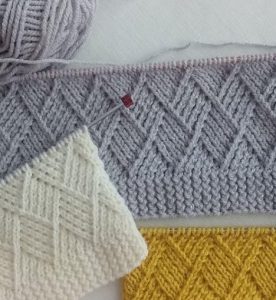The diamond pattern in the circle is the basis of knitting. It uses a traditional 1x1 elastic band, which consists of crossed loops. It is a universal pattern, as it fits with any clothing. Looks impressive on cuffs and collars. Knitting a crossed elastic band is as easy as shelling pears, so even beginners can master the pattern.

Knitting process
To make a crossed diamond pattern, you must adhere to the following plan:
- Cast on the required number of stitches on the knitting needles.
- The first row is an edge stitch, alternate 1 knit stitch and 1 purl stitch.
- When the first row is knitted, the knitting of the elastic itself will begin from the second.
- Remove the first edge loop and take the second purl stitch crossed. To do this, place the working thread below the loop, and then purl it.
- To knit the next knit stitch, you need to pick up the second wall of the loop one row below with your right knitting needle. Throw it onto the left knitting needle.
- Knit both loops with the front one behind the second wall, like a crossed knit one.
- Repeat by analogy, and at the end knit a row with an edge loop.
- Knit all further rows like the second.
If the back and front sides look the same, then you did everything right.
What other types of rubber bands are there?
In addition to the diamond pattern, you can knit the following elements:
- Simple. The most common type of elastic, knitting which is considered the basis of all other techniques. To create a pattern, you need to alternate the front and back loops, and then vice versa.
- English. This is a traditional knitting option that can be found in almost every product, such as a sweater, scarf or hat. This elastic band is perfect for beginners to master knitting techniques. The difference between the English method and the others is the odd number of loops.
- Semi-English. It is similar in execution to the previous one. The only thing that distinguishes them from each other is an even number of loops. The first row is made entirely by alternating yarn over and knit stitch. The second row involves knitting with a double crochet from the previous row.
- False. Externally, the elastic is similar to the English one, but the knitting technique is completely different. The peculiarity of false elastic is the low yarn consumption. At the same time, the texture is not so dense and elastic. This is due to the low knitting density.
- Double. This type of rubber band is also called hollow, since when it is created, elements similar to empty columns are formed. The double elastic band retains its shape perfectly. It has found application in the creation of collars, belts and other parts for which elasticity is important.
- Polish. It is used when knitting children's clothing, as it is not dense and has a soft texture. When casting on loops, their number should be divided by 4.
- Italian. This is a decorative element that can be used when creating openwork items. Italian elastic bands will make any item more festive and elegant.
- Italian. This elastic band is also decorative. This knitting technique is used when creating a jumper or cardigan, where it is necessary to use a voluminous finish.
- American. Its peculiarity is its tight knitting. Used to create warm, winter clothes. The resulting fabric will retain heat perfectly and not be blown through. Thanks to the dense stringing of the loops, the elastic band receives a special texture that perfectly protects from cold wind.

Each of the above options is actively used to create one type of clothing or another. But the crossed elastic band is a universal element, as it will be appropriate on the things of adults and children. The process of creating it is as simple as possible, but it looks interesting and unusual.


 0
0





